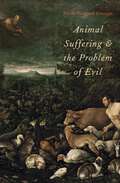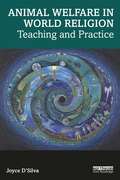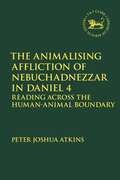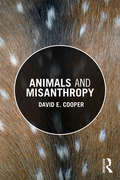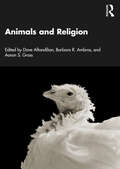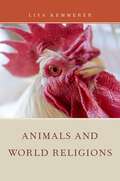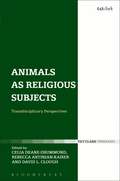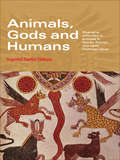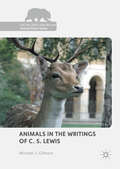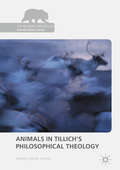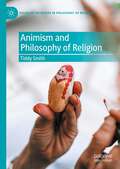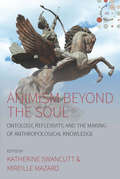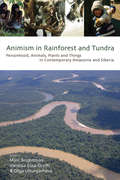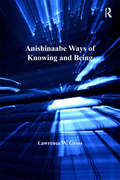- Table View
- List View
Animal Sacrifice in the Roman Empire (31 BCE-395 CE): Power, Communication, and Cultural Transformation
by J. B. RivesFor over a thousand years, the practice of animal sacrifice held a central place in ancient Graeco-Roman culture as a means of both demonstrating piety to the gods and structuring social relationships. As Christianity took root in Rome in the third century CE, the cultural role of this practice changed dramatically. In Animal Sacrifice in the Roman Empire (31 BCE-395 CE), J. B. Rives explores the shifting socio-economic, political, and cultural significance of animal sacrifice in this crucial period of change. Drawing on literary, epigraphic, archaeological, art historical, philosophical, and scriptural evidence, this volume provides a comprehensive and detailed study of the central role of animal sacrifice in the ancient Mediterranean world and traces the changes in its social function and cultural significance during the period when that world became Christianized. By focusing on the evolution of this specific cultural practice, Rives illustrates the larger phenomenon of the religious and cultural transformation taking place in the Graeco-Roman world in the third and fourth centuries CE, providing a unique perspective which will appeal to scholars across religious and classical studies.
Animal Sacrifice in the Roman Empire (31 BCE-395 CE): Power, Communication, and Cultural Transformation
by J. B. RivesFor over a thousand years, the practice of animal sacrifice held a central place in ancient Graeco-Roman culture as a means of both demonstrating piety to the gods and structuring social relationships. As Christianity took root in Rome in the third century CE, the cultural role of this practice changed dramatically. In Animal Sacrifice in the Roman Empire (31 BCE-395 CE), J. B. Rives explores the shifting socio-economic, political, and cultural significance of animal sacrifice in this crucial period of change. Drawing on literary, epigraphic, archaeological, art historical, philosophical, and scriptural evidence, this volume provides a comprehensive and detailed study of the central role of animal sacrifice in the ancient Mediterranean world and traces the changes in its social function and cultural significance during the period when that world became Christianized. By focusing on the evolution of this specific cultural practice, Rives illustrates the larger phenomenon of the religious and cultural transformation taking place in the Graeco-Roman world in the third and fourth centuries CE, providing a unique perspective which will appeal to scholars across religious and classical studies.
Animal Suffering and the Problem of Evil
by Nicola Hoggard CreeganNicola Hoggard Creegan offers a compelling examination of the problem of evil in the context of animal suffering, disease, and extinction and the violence of the evolutionary process. Using the parable of the wheat and the tares as a hermeneutical lens for understanding the tragedy and beauty of evolutionary history, she shows how evolutionary theory has deconstructed the primary theodicy of historic Christianity-the Adamic fall-while scientific research on animals has increased appreciation of animal sentience and capacity for suffering. Animal Suffering and the Problem of Evil responds to this new theodic challenge. Hoggard Creegan argues that nature can be understood as an interrelated mix of the perfect and the corrupted: the wheat and the tares. At times the good is glimpsed, but never easily or unequivocally. She then argues that humans are not to blame for all evil because so much evil preceded human becoming. Finally, she demonstrates that faith requires a confidence in the visibility of the work of God in nature, regardless of how infinitely subtle and almost hidden it is, affirming that there are ways of perceiving the evolutionary process beyond that "nature is red in tooth and claw."
Animal Welfare in World Religion: Teaching and Practice
by Joyce D'SilvaThis unique and readable book examines the relationship between religion and animal welfare, taking a detailed dive into the teachings and practices of the major world religions. While there are many books expounding the beliefs of the major religions and many about the rights and welfare of animals, there are few linking the two. With each chapter focusing on one of the five major religions – Judaism, Christianity, Islam, Hinduism and Buddhism – the book explores the beliefs and practices which drive our relationship with and treatment of animals. The book draws on the scriptures of the major faiths and includes the voices of leading historical religious figures and contemporary faith leaders. In doing so, it compares the teachings of old with contemporary practices and showcases the impact of the major religions on both the protection and exploitation of animals, from running animal sanctuaries, to participating in or condoning cruel sports and factory farming. Importantly, the book also includes a chapter looking beyond the major world religions, where it examines a wider range of beliefs and practices, including Indigenous peoples from the USA and Australia, Jainism, Sikhism and Rastafarianism, to provide fascinating insights into another range of beliefs and views on the human-animal relationship. Overall, this book challenges and encourages religious leaders and followers to re-examine their teachings and to prioritise the well-being of animals. This book is essential reading for those interested in the role of religion in animal welfare, human-animal studies, and animal welfare and ethics more broadly.
Animal Welfare in World Religion: Teaching and Practice
by Joyce D'SilvaThis unique and readable book examines the relationship between religion and animal welfare, taking a detailed dive into the teachings and practices of the major world religions. While there are many books expounding the beliefs of the major religions and many about the rights and welfare of animals, there are few linking the two. With each chapter focusing on one of the five major religions – Judaism, Christianity, Islam, Hinduism and Buddhism – the book explores the beliefs and practices which drive our relationship with and treatment of animals. The book draws on the scriptures of the major faiths and includes the voices of leading historical religious figures and contemporary faith leaders. In doing so, it compares the teachings of old with contemporary practices and showcases the impact of the major religions on both the protection and exploitation of animals, from running animal sanctuaries, to participating in or condoning cruel sports and factory farming. Importantly, the book also includes a chapter looking beyond the major world religions, where it examines a wider range of beliefs and practices, including Indigenous peoples from the USA and Australia, Jainism, Sikhism and Rastafarianism, to provide fascinating insights into another range of beliefs and views on the human-animal relationship. Overall, this book challenges and encourages religious leaders and followers to re-examine their teachings and to prioritise the well-being of animals. This book is essential reading for those interested in the role of religion in animal welfare, human-animal studies, and animal welfare and ethics more broadly.
Animalising Affliction of Nebuchadnezzar in Daniel 4: Reading Across the Human-Animal Boundary (The Library of Hebrew Bible/Old Testament Studies)
by Peter Joshua AtkinsThis is a detailed investigation into the nature of Nebuchadnezzar's animalising affliction in Daniel 4 and the degree to which he is depicted as actually becoming an animal. PeterAtkins examines two predominant lines of interpretation: either Nebuchadnezzar undergoes a physical metamorphosis of some kind into an animal form; or diverse other readings that specifically preclude or deny an animal transformation of the king. By providing an extensive study of these interpretative opinions, alongside innovative assessments of ancient Mesopotamian divine-human-animal boundaries, Atkins ultimately demonstrates how neither of these traditional interpretations best reflect the narrative events. While there have been numerous metamorphic interpretations of Daniel 4, these are largely reliant upon later developments within the textual tradition and are not present in the earliest edition of Nebuchadnezzar's animalising affliction. Atkins' study displays that when Daniel 4 is read in the context of Mesopotamian texts, which appear to conceive of the human-animal boundary as being indicated primarily in relation to possession or lack of the divine characteristic of wisdom, the affliction represents a far more significant categorical change from human to animal than has hitherto been identified.
Animals and Misanthropy
by David E. CooperThis engaging volume explores and defends the claim that misanthropy is a justified attitude towards humankind in the light of how human beings both compare with and treat animals. Reflection on differences between humans and animals helps to confirm the misanthropic verdict, while reflection on the moral and other failings manifest in our treatment of animals illuminates what is wrong with this treatment. Human failings, it is argued, are too entrenched to permit optimism about the future of animals, but ways are proposed in which individual people may accommodate to the truth of misanthropy through cultivating mindful, humble and compassionate relationships to animals. Drawing on both Eastern and Western philosophical traditions David E. Cooper offers an original and challenging approach to the complex field of animal ethics.
Animals and Misanthropy
by David E. CooperThis engaging volume explores and defends the claim that misanthropy is a justified attitude towards humankind in the light of how human beings both compare with and treat animals. Reflection on differences between humans and animals helps to confirm the misanthropic verdict, while reflection on the moral and other failings manifest in our treatment of animals illuminates what is wrong with this treatment. Human failings, it is argued, are too entrenched to permit optimism about the future of animals, but ways are proposed in which individual people may accommodate to the truth of misanthropy through cultivating mindful, humble and compassionate relationships to animals. Drawing on both Eastern and Western philosophical traditions David E. Cooper offers an original and challenging approach to the complex field of animal ethics.
Animals and Religion
by Dave Aftandilian Barbara R. Ambros Aaron S. GrossWhat do animals—other than human animals—have to do with religion? How do our religious ideas about animals affect the lives of real animals in the world? How can we deepen our understanding of both animals and religion by considering them together? Animals and Religion explores how animals have crucially shaped how we understand ourselves, the other living beings around us, and our relationships with them.Through incisive analyses of religious examples from around the world, the original contributions to this volume demonstrate how animals have played key roles in every known religious tradition, whether as sacred beings, symbols, objects of concern, fellow creatures, or religious teachers. And through our religious imagination, ethics, and practices, we have deeply impacted animal lives, whether by domesticating, sacrificing, dominating, eating, refraining from eating, blessing, rescuing, releasing, commemorating, or contemplating them. Drawing primarily on perspectives from religious studies and Christian theology, augmented by cutting-edge work in anthropology, biology, philosophy, and psychology, Animals and Religion offers the reader a richer understanding of who animals are and who we humans are. Do animals have emotions? Do they think or use language? Are they persons? How we answer questions like these affects diverse aspects of religion that shape not only how we relate to other animals, but also how we perceive and misperceive each other along axes of gender, race, and (dis)ability.Accessibly written and thoughtfully argued, Animals and Religion will interest anyone who wants to learn more about animals, religion, and what it means to be a human animal.
Animals and Religion
What do animals—other than human animals—have to do with religion? How do our religious ideas about animals affect the lives of real animals in the world? How can we deepen our understanding of both animals and religion by considering them together? Animals and Religion explores how animals have crucially shaped how we understand ourselves, the other living beings around us, and our relationships with them.Through incisive analyses of religious examples from around the world, the original contributions to this volume demonstrate how animals have played key roles in every known religious tradition, whether as sacred beings, symbols, objects of concern, fellow creatures, or religious teachers. And through our religious imagination, ethics, and practices, we have deeply impacted animal lives, whether by domesticating, sacrificing, dominating, eating, refraining from eating, blessing, rescuing, releasing, commemorating, or contemplating them. Drawing primarily on perspectives from religious studies and Christian theology, augmented by cutting-edge work in anthropology, biology, philosophy, and psychology, Animals and Religion offers the reader a richer understanding of who animals are and who we humans are. Do animals have emotions? Do they think or use language? Are they persons? How we answer questions like these affects diverse aspects of religion that shape not only how we relate to other animals, but also how we perceive and misperceive each other along axes of gender, race, and (dis)ability.Accessibly written and thoughtfully argued, Animals and Religion will interest anyone who wants to learn more about animals, religion, and what it means to be a human animal.
Animals and World Religions
by Lisa KemmererDespite increasing public attention to animal suffering, little seems to have changed: Human beings continue to exploit billions of animals in factory farms, medical laboratories, and elsewhere. In this wide-ranging and perceptive study, Lisa Kemmerer shows how spiritual writings and teachings in seven major religious traditions can help people to consider their ethical obligations toward other creatures. Dr. Kemmerer examines the role of nonhuman animals in scripture and myth, in the lives of religious exemplars, and by drawing on foundational philosophical and moral teachings. She begins with a study of indigenous traditions around the world, then focuses on the religions of India (Hindu, Buddhist, and Jain) and China (Daoism and Confucianism), and finally, religions of the Middle East (Judaism, Christianity, and Islam). At the end of each chapter, Kemmerer explores the inspiring lives and work of contemporary animal advocates who are motivated by a personal religious commitment. Animals and World Religions demonstrates that rethinking how we treat nonhuman animals is essential for anyone claiming one of the world's great religions.
Animals and World Religions
by Lisa KemmererDespite increasing public attention to animal suffering, little seems to have changed: Human beings continue to exploit billions of animals in factory farms, medical laboratories, and elsewhere. In this wide-ranging and perceptive study, Lisa Kemmerer shows how spiritual writings and teachings in seven major religious traditions can help people to consider their ethical obligations toward other creatures. Dr. Kemmerer examines the role of nonhuman animals in scripture and myth, in the lives of religious exemplars, and by drawing on foundational philosophical and moral teachings. She begins with a study of indigenous traditions around the world, then focuses on the religions of India (Hindu, Buddhist, and Jain) and China (Daoism and Confucianism), and finally, religions of the Middle East (Judaism, Christianity, and Islam). At the end of each chapter, Kemmerer explores the inspiring lives and work of contemporary animal advocates who are motivated by a personal religious commitment. Animals and World Religions demonstrates that rethinking how we treat nonhuman animals is essential for anyone claiming one of the world's great religions.
Animals as Religious Subjects: Transdisciplinary Perspectives
by Celia Deane-Drummond Rebecca Artinian-Kaiser David L. CloughThis book examines one of the most pressing cultural concerns that surfaced in the last decade - the question of the place and significance of the animal. This collection of essays represents the outcome of various conversations regarding the animal studies and shows multidisciplinarity at its very best, namely, a rigorous approach within one discipline in conversation with others around a common theme. The contributors discuss the most relevant disciplines regarding this conversation, namely: philosophy, anthropology, religious studies, theology, history of religions, archaeology and cultural studies. The first section, Thinking about Animals, explores philosophical, anthropological and religious perspectives, raising general questions about the human perception of animals and its crucial cultural significance. The second section explores the intriguing topic of the way animals have been used historically as religious symbols and in religious rituals. The third section re-examines some Christian theological and biblical approaches to animals in the light of current concerns. The final section extends the implications of traditional views about other animals to more specific ethical theories and practices.
Animals as Religious Subjects: Transdisciplinary Perspectives
by Celia Deane-Drummond David L. Clough Rebecca Artinian-KaiserThis book examines one of the most pressing cultural concerns that surfaced in the last decade - the question of the place and significance of the animal. This collection of essays represents the outcome of various conversations regarding the animal studies and shows multidisciplinarity at its very best, namely, a rigorous approach within one discipline in conversation with others around a common theme. The contributors discuss the most relevant disciplines regarding this conversation, namely: philosophy, anthropology, religious studies, theology, history of religions, archaeology and cultural studies. The first section, Thinking about Animals, explores philosophical, anthropological and religious perspectives, raising general questions about the human perception of animals and its crucial cultural significance. The second section explores the intriguing topic of the way animals have been used historically as religious symbols and in religious rituals. The third section re-examines some Christian theological and biblical approaches to animals in the light of current concerns. The final section extends the implications of traditional views about other animals to more specific ethical theories and practices.
Animals, Gods and Humans: Changing Attitudes to Animals in Greek, Roman and Early Christian Thought
by Ingvild Saelid GilhusConsulting a wide range of key texts and source material, Animals, Gods and Humans covers 800 years and provides a detailed analysis of early Christian attitudes to, and the position of, animals in Greek and Roman life and thought. Both the pagan and Christian conceptions of animals are rich and multilayered, and Ingvild Sælid Gilhus expertly examines the dominant themes and developments in the conception of animals. Including study of: biographies of figures such as Apollonus of Tyana; natural history; the New Testament via Gnostic texts; the church fathers; and from pagan and Christian criticism of animal sacrifice, to the acts of martyrs, the source material and detailed analysis included in this volume make it a veritable feast of information for all classicists.
Animals, Gods and Humans: Changing Attitudes to Animals in Greek, Roman and Early Christian Thought
by Ingvild Saelid GilhusConsulting a wide range of key texts and source material, Animals, Gods and Humans covers 800 years and provides a detailed analysis of early Christian attitudes to, and the position of, animals in Greek and Roman life and thought. Both the pagan and Christian conceptions of animals are rich and multilayered, and Ingvild Sælid Gilhus expertly examines the dominant themes and developments in the conception of animals. Including study of: biographies of figures such as Apollonus of Tyana; natural history; the New Testament via Gnostic texts; the church fathers; and from pagan and Christian criticism of animal sacrifice, to the acts of martyrs, the source material and detailed analysis included in this volume make it a veritable feast of information for all classicists.
Animals in the Writings of C. S. Lewis (The Palgrave Macmillan Animal Ethics Series)
by Michael J. GilmourThis book examines C. S. Lewis’s writings about animals, and the theological bases of his opposition to vivisection and other cruelties. It argues Genesis is central to many of these ethical musings and the book’s organization reflects this. It treats in turn Lewis’s creative approaches to the Garden of Eden, humanity’s “dominion” over the earth, and the loss of paradise with all the catastrophic consequences for animals it presaged. The book closes looking at Lewis’s vision of a more inclusive community. Though he left no comprehensive summary of his ideas, the Narnia adventures and science fiction trilogy, scattered poems and his popular theology inspire affection and sympathy for the nonhuman. This study challenges scholars to reassess Lewis as not only a literary critic and children’s author but also an animal theologian of consequence, though there is much here for all fans of Mr. Bultitude and Reepicheep to explore.
Animals in Tillich's Philosophical Theology (The Palgrave Macmillan Animal Ethics Series)
by Abbey-Anne SmithThis book explores how Paul Tillich’s systematic theology, focusing on the concepts of being and reason can benefit nonhuman animals, while also analysing how taking proper account of nonhuman animals can prove immensely beneficial. The author first explains the body of Tillich’s system, examining reason and revelation, life and the spirit, and history and the kingdom of God. The second section undertakes a critical analysis of Tillichian concepts and their adequacy in relation to nonhuman animals, addressing topics such as Tillich’s concept of ‘technical reason’ and the multidimensional unity of life. The author concludes by discussing the positive concepts in Tillich’s systematic theology with respect to nonhuman animals and creation, including the concept of universal salvation and Tillich’s interpretation of nonhuman animals and the Fall in Genesis.
Animism and Philosophy of Religion (Palgrave Frontiers in Philosophy of Religion)
by Tiddy SmithMainstream philosophy of religion has persistently failed to engage seriously or critically with animist beliefs and practices. The field that is now called "philosophy of religion" could quite easily be renamed "philosophy of theism" with few lecturers on the subject having to change their lecture notes. It is the aim of this volume to rectify that failure and to present animism as a live option among the plethora of religious worldviews. The volume addresses four major questions: 1. What is this thing called "animism"? 2. Are there any arguments for or against animist belief and practice? 3. What is the relationship between animism, naturalism, and the sciences? And 4. Should we take animism seriously? Animism and Philosophy of Religion is intended to be the first authoritative scholarly volume on the issue of animism and its place in the philosophy of religion. Ambitiously, it aims to act as the cornerstone volume for future work on the subject and as a key text for courses engaging with the subject.
Animism beyond the Soul: Ontology, Reflexivity, and the Making of Anthropological Knowledge (Studies in Social Analysis #6)
by Katherine Swancutt and Mireille MazardHow might we envision animism through the lens of the ‘anthropology of anthropology’? The contributors to this volume offer compelling case studies that demonstrate how indigenous animistic practices, concepts, traditions, and ontologies are co-authored in highly reflexive ways by anthropologists and their interlocutors. They explore how native epistemologies, which inform anthropological notions during fieldwork, underpin the dialogues between researchers and their participants. In doing so, the contributors reveal ways in which indigenous thinkers might be influenced by anthropological concepts of the soul and, equally, how they might subtly or dramatically then transform those same concepts within anthropological theory.
Animism in Rainforest and Tundra: Personhood, Animals, Plants and Things in Contemporary Amazonia and Siberia
by UnknownAmazonia and Siberia, classic regions of shamanism, have long challenged ‘western’ understandings of man’s place in the world. By exploring the social relations between humans and non-human entities credited with human-like personhood (not only animals and plants, but also ‘things’ such as artifacts, trade items, or mineral resources) from a comparative perspective, this volume offers valuable insights into the constitutions of humanity and personhood characteristic of the two areas. The contributors conducted their ethnographic fieldwork among peoples undergoing transformative processes of their lived environments, such as the depletion of natural resources and migration to urban centers. They describe here fundamental relational modes that are being tested in the face of change, presenting groundbreaking research on personhood and agency in shamanic societies and contributing to our global understanding of social and cultural change and continuity.
Anishinaabe Ways of Knowing and Being (Vitality of Indigenous Religions)
by Lawrence W. GrossVery few studies have examined the worldview of the Anishinaabeg from within the culture itself and none have explored the Anishinaabe worldview in relation to their efforts to maintain their culture in the present-day world. This book fills that gap. Focusing mainly on the Minnesota Anishinaabeg, Lawrence Gross explores how their worldview works to create a holistic way of living. However, as Gross also argues, the Anishinaabeg saw the end of their world early in the 20th century and experienced what he calls 'postapocalypse stress syndrome.' As such, the book further explores how the values engendered by the worldview of the Anishinaabeg are finding expression in the modern world as they seek to rebuild their society.
Anishinaabe Ways of Knowing and Being (Vitality of Indigenous Religions)
by Lawrence W. GrossVery few studies have examined the worldview of the Anishinaabeg from within the culture itself and none have explored the Anishinaabe worldview in relation to their efforts to maintain their culture in the present-day world. This book fills that gap. Focusing mainly on the Minnesota Anishinaabeg, Lawrence Gross explores how their worldview works to create a holistic way of living. However, as Gross also argues, the Anishinaabeg saw the end of their world early in the 20th century and experienced what he calls 'postapocalypse stress syndrome.' As such, the book further explores how the values engendered by the worldview of the Anishinaabeg are finding expression in the modern world as they seek to rebuild their society.
Anna and the Black Knight: Incorporating Anna’s Book
by FynnThough her short life was vividly presented in Mister God, This is Anna, its huge success led to Fynn being inundated to write more about his experiences with her.

